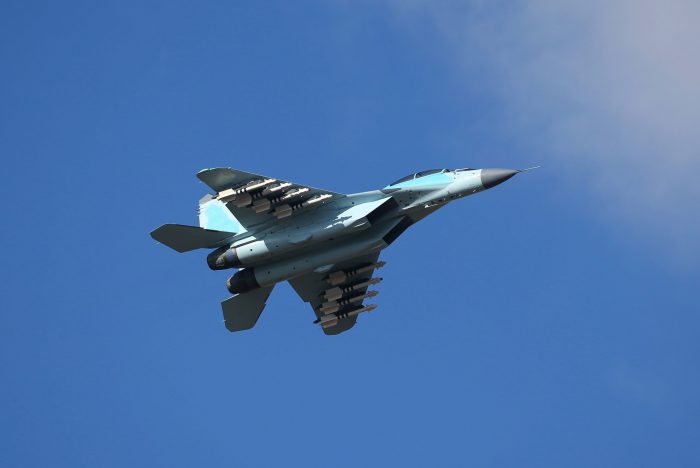Russia’s MiG Corporation is developing smart target recognition systems based on neural networks for MiG series aircraft, especially the 4++ generation MiG-35 fighter, the Russian state media reported.
“The work is underway on the system of automated taxiing after airplane landing and on the smart target identification system based on neural networks, enabling target identification by a fragment,” TASS quoted the Russian aircraft manufacturer as saying.
Although the MiG-35 fighter jet already comes with an expert system powered by artificial intelligence elements, the addition of the new smart target recognition is expected to significantly advance the sensing capability of the fighter, which is a product of further development of MiG-29K/KUB and MiG-29M/M2 fighters.
“Possibly, the system would facilitate fragment RF (radio frequency) return based LO (low observable) fighter identification? MiG is also implementing a neural network-based system for automated landing and taxiing allowing a MiG-35 to return to base after pilot incapacitation,” observed the former IAF pilot Vijainder K Thakur.

“Clearly, the Russians are thinking ahead. It is likely that the use of first-generation laser weapons on fighters would often result in adversary fighter pilot incapacitation,” he adds.
He says that when it comes to the Indian Air Force (IAF), he has consistently advocated platform upgrades in preference to new platform acquisitions.
“For example, neural network AI upgrades to MiG-29 UPG platforms may well be more cost-effective than MRFA acquisition,” he adds.
Neural networks backed systems are being increasingly adopted in the future air combat systems, with even Europe’s upcoming Future Combat Air System (FCAS) committing to integrate such technology.
The adoption of AI is accelerating in modern warfare, especially air combat and reconnaissance. Neural networks, along with machine learning and neuromorphic computing are transforming the concept of modern warfighting, with the next-generation aircraft, both manned and unmanned, exploiting them for enhanced operational efficiency and combat edge.
India, along with other countries, is prioritizing research and development in AI-driven systems in combat aircraft, with the country already on the path to implementing the AI concepts for the air force, the IAF chief recently said at an event.
According to Thakur, a neural network is an essential ingredient for AI.
“Traditional computing algorithms support decision making. Neural networking algorithms facilitate “learning” by assigning weightages to neural network nodes. Traditional computer algorithms would not be able to discriminate a weak RF signal return from a LO fighter from RF noise. A neural network-based algorithm can learn that such “noise” corresponds to an RF return from a radar painting an F-35 fighter,” he adds.
Citing an example, the veteran pilot said that when crossing a street, the neural network in our brain doesn’t signal safety by computing relative velocities of traffic on either side. “It relies on its learning that the visual picture captured by the eyes corresponds to a safe crossing,” he adds.
He is of the opinion that the IAF needs to skip fifth-generation fighter development in preference to sixth-generation fighter system concept, comprising manned aircraft operating with penetrating LO UCAVs (Unmanned Combat Aerial Vehicles) for targeting, attack, and reconnaissance.
“My point is that sensors, weapon systems, computing power, and algorithms make an aircraft potent, not the platform. The Rafale is an early 1980s platform. It is potent because France has continuously developed its sensor, weapon systems, and computing abilities.
The IAF needs to focus on improving its platforms through improved sensors, weapons, and computing power. Given the same kind of weapons, the Su-30MKI, MiG-29UPG would be far more potent than the Rafale,” says the veteran pilot.
India has been using the various variants of MiG-29s, on which the basic design of the new MiG-35 is based. In fact, the country has ordered more MiG-29Ks amid the worsening situation in its squadron strength.
The country has been trying to offer the new variant to India since the last decade, even offering transfer of technology and setting up of production bases locally. But the performance of the jet has been unimpressive, with its testing getting delayed consecutively over the last few years, damping the trust of potential foreign customers.
Although many countries like Turkey and Pakistan seem interested in MiG-35 as the recent news indicated.
Thakur has for long maintained that IAF’s excessive focus on platform acquisition rather than sensor and weapon system upgrades is imprudent and short-sighted.
“Unmanned platforms in combination with advanced sensors, networking, weapon systems, and computing power will give the IAF an opportunity to catch up with the West in a manner akin to switching to cellular networks without catching up with land-based communication infrastructure,” he says.
Follow EurAsian Times on Google News